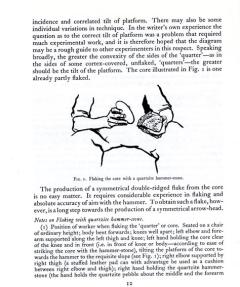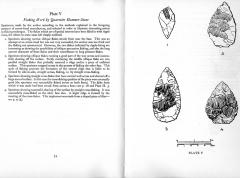ENGLAND: THE OTHER WITHIN
Analysing the English Collections at the Pitt Rivers Museum
The manufacture of a flint arrow-head by quartzite hammer-stone
Alison Petch,
Researcher 'The Other Within' project
Francis Knowles published this, the first Occasional Paper on Technology by the Pitt Rivers Museum, in 1944. The paper was edited by Thomas Kenneth Penniman and Beatrice Blackwood, who also wrote the preface. In that they praise Knowles:
Sir Francis Knowles has worked for many years in this Museum and in the National Museum of Canada, and has long been in the confidence of the gun-flint makers of Brandon. No man is more familiar than he with the techniques of Stone Age peoples, ancient and modern, and few men have his ability to make beautiful stone implements with the simple tools used by the original makers. Everywhere in the primitive world the archaeological and ethnological record shows these simple tools in use, namely, the quartzite hammer-stone and the antler and bone pressure-flaker. These are the only tools used by the author, and it is because he used the same tools and materials as the original makers that we present his work to the public as a help to understanding the craft of our ancestors and other Stone Age peoples. Though short, this paper includes the result of many years of observation and experiment, years during which he has enriched this Museum with an unrivalled teaching collection. His discovery of 'turning the edge' is alone a notable contribution. [Knowles, 1944: 3]
It is clear from the opening words of the paper that Knowles had been interested to see whether he could make a facsimile of a flaked arrowhead using 'primitive materials—the quartzite pebble for percussion and the antler-tine for pressure work'. [Knowles, 1944: 7] He had as his model 'the work of the ancient arrow-head maker'.
Knowles had acquired considerable skills as a flint-knapper:
'The work necessitated a considerable period of time. In the first place, experience must be gained in the use of the quartzite hammer-stone, and long practice needed to acquire with it the requisite skill and accuracy of aim. Secondly, a difficult problem had to be solved before flaking could be carried successfully across both faces of the flake or piece of flint and an arrow-head produced of symmetrical shape, thin section, and flaked all over.' [Knowles, 1944: 7]
The rest of the paper provides practical advice on how to produce a flaked arrow-head, including the selection of the quartzite hammer, the type of flint, the arrow-heads used as models ('American-Indian'), how to hold the core, and the stages of manufacture.
In his acknowledgements Knowles says:
'To the late Professor Henry Balfour, formerly Curator of the Pitt Rivers Museum, I am indebted for much helpful advice in the course of my experiments and compilation of this account. To Professor Alfred S. Barnes, with whom I have collaborated for a number of years in experiments of flint fracture, I am deeply indebted for advice and criticism that has been of the very greatest assistance to me.
There is a follow-up account of the impact this book had in the preface to Knowles' second Occasional Paper, Stone workers Progress:
In the first paper of this series, The Manufacture of a flint arrow-head ... the writer made the first fully clear and literate presentation of the 'turned edge', or prepared marginal striking-platform necessary for getting good flakes across both sides to meet and make a thin section. Professor A.P. Elkin of Sydney had noted that H. Basedow in The Australian Aboriginal of 1929 had mentioned rubbing and rasping the edge to clear away small chips, and on receiving a copy of Sir Francis Knowles;s paper, sent observers among the aboriginal stone workers to watch their procedure. They found that the makers of stone and glass lance-heads turned the edges to prepare striking-platforms exactly as Sir Francis Knowles had done in making flint implements. [Knowles, 1953: 3]
In Johnson's account of flint knapping in the nineteenth and twentieth centuries, he describes this work:
Knowles's The Manufacture ... [is] a detailed discussion of the manufacture of one artifact from core to final basal notching. Knowles's description is excellent and cannot really be condensed. By following it carefully, I am sure that it would be possible for a neophyte to produce a passable point. ... Not only is Knowles's prose clear, but so are his illustrations. [Johnson, 1978: 349]
Further Reading
Johnson, L. Lewis et al. 1978. 'A history of flint-knapping experimentation 1838-1976' Current Anthropology, vol. 19 no. 2 (June 1978) pp. 337-372

